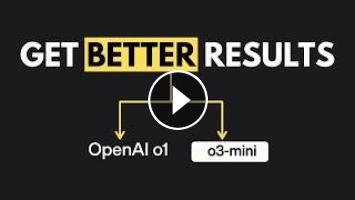Prompting reasoning models like GPT-4 O1, Claude Opus, or DeepSeek isn't the same as prompting standard GPT models. In fact, using the same techniques can sometimes make your results worse.
In this video, I’ll walk you through 7 best practice prompting tips designed specifically for reasoning models—plus show you an actual prompt structure used by OpenAI’s Greg Brockman for their O1 model.
You’ll learn how to think less like a prompt engineer, and more like a collaborator—guiding the model through complex tasks and conversations.
???? What You’ll Learn:
1️⃣ The 7 key tips for prompting reasoning models
2️⃣ Why you should avoid chain-of-thought prompts with these models
3️⃣ When to use zero-shot vs few-shot prompting
4️⃣ A real-world prompt format used by OpenAI leadership
⏳ Timestamps:
00:00 – Why prompting reasoning models is different
00:14 – Tip 1: Keep prompts simple and direct
00:42 – Tip 2: Don't "prompt and ghost"—be conversational
01:10 – Tip 3: Avoid chain-of-thought prompts (they already reason!)
01:40 – Tip 4: Use delimiters (markdown, section titles, XML-style)
02:20 – Tip 5: Start with zero-shot, try few-shot if needed
02:58 – Tip 6: Provide clear task constraints upfront
03:22 – Tip 7: Give a high-level goal, not micromanaged steps
03:50 – Bonus: Greg Brockman’s “Anatomy of a Prompt” (used for O1)
04:38 – Final thoughts: Reasoning vs GPT prompts—know the difference
---
???? Tools & Models Mentioned:
→Reasoning Models: GPT-4 O1, O3-mini, Claude Opus, DeepSeek
→ Prompt Design Tips from: Greg Brockman (OpenAI President)
→ Techniques: Delimiters, zero-shot vs few-shot, success criteria
---
???? Key Takeaway:
Prompting reasoning models is less about rigid engineering and more about clear goals, simple language, and good structure. The better your prompts, the better your insights.
---
????WATCH NEXT:
→ How I use Notebook LM: Google's Killer AI Note Taking & Research Assistant: https://youtu.be/JO74lXhU95c
→ The Problem-Solving framework for better products: https://youtu.be/FS6Ak9JJfgw
→ How to improve your thinking with AI: https://youtu.be/cvXUvBrQKU0
---
LEARN WITH ME ↓
???? Visit my blog for more insights: https://stealthesethoughts.com
???? Get my free weekly newsletter every Tuesday morning: https://stealthesethoughts.com/newsletter
???? Say hello on LinkedIn: https://uk.linkedin.com/in/rstevensonuk
???? Hire me to train your team or for 1:1 AI training: https://rossstevensonai.com/
__
WHO AM I?
Hey ???? I’m Ross, a Chief Learning Strategist, and founder at Steal These Thoughts! enabling humans to improve performance and skills with technology. I share strategies and tools to help you improve your skills with modern tech.
In this video, I’ll walk you through 7 best practice prompting tips designed specifically for reasoning models—plus show you an actual prompt structure used by OpenAI’s Greg Brockman for their O1 model.
You’ll learn how to think less like a prompt engineer, and more like a collaborator—guiding the model through complex tasks and conversations.
???? What You’ll Learn:
1️⃣ The 7 key tips for prompting reasoning models
2️⃣ Why you should avoid chain-of-thought prompts with these models
3️⃣ When to use zero-shot vs few-shot prompting
4️⃣ A real-world prompt format used by OpenAI leadership
⏳ Timestamps:
00:00 – Why prompting reasoning models is different
00:14 – Tip 1: Keep prompts simple and direct
00:42 – Tip 2: Don't "prompt and ghost"—be conversational
01:10 – Tip 3: Avoid chain-of-thought prompts (they already reason!)
01:40 – Tip 4: Use delimiters (markdown, section titles, XML-style)
02:20 – Tip 5: Start with zero-shot, try few-shot if needed
02:58 – Tip 6: Provide clear task constraints upfront
03:22 – Tip 7: Give a high-level goal, not micromanaged steps
03:50 – Bonus: Greg Brockman’s “Anatomy of a Prompt” (used for O1)
04:38 – Final thoughts: Reasoning vs GPT prompts—know the difference
---
???? Tools & Models Mentioned:
→Reasoning Models: GPT-4 O1, O3-mini, Claude Opus, DeepSeek
→ Prompt Design Tips from: Greg Brockman (OpenAI President)
→ Techniques: Delimiters, zero-shot vs few-shot, success criteria
---
???? Key Takeaway:
Prompting reasoning models is less about rigid engineering and more about clear goals, simple language, and good structure. The better your prompts, the better your insights.
---
????WATCH NEXT:
→ How I use Notebook LM: Google's Killer AI Note Taking & Research Assistant: https://youtu.be/JO74lXhU95c
→ The Problem-Solving framework for better products: https://youtu.be/FS6Ak9JJfgw
→ How to improve your thinking with AI: https://youtu.be/cvXUvBrQKU0
---
LEARN WITH ME ↓
???? Visit my blog for more insights: https://stealthesethoughts.com
???? Get my free weekly newsletter every Tuesday morning: https://stealthesethoughts.com/newsletter
???? Say hello on LinkedIn: https://uk.linkedin.com/in/rstevensonuk
???? Hire me to train your team or for 1:1 AI training: https://rossstevensonai.com/
__
WHO AM I?
Hey ???? I’m Ross, a Chief Learning Strategist, and founder at Steal These Thoughts! enabling humans to improve performance and skills with technology. I share strategies and tools to help you improve your skills with modern tech.
- Category
- AI prompts












Comments